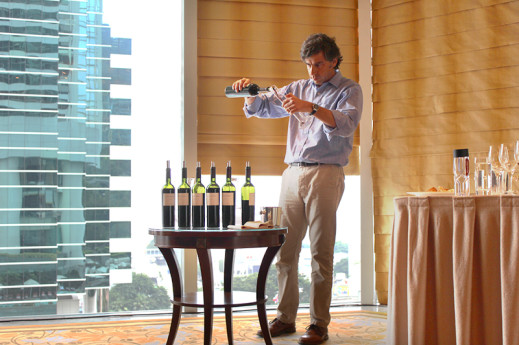
Enrique Tirado, Don Melchor chief winemaker explains his single varietal blending process
Can a single varietal wine still be called a blend? The answer: yes, it can – without doubt. Don Melchor, Chilean winery Concha y Toro’s flagship wine proved this point recently – in a masterclass hosted for the very first time in Hong Kong.
Blending has long been standard practice among winemakers to produce signature consistent quality and style. Champagne producers are known for keeping reserve wines of each vintage to use in blends of non-vintage releases. ‘Bordeaux Blend’ is a term coined to describe any wines, Old World or New World, made from varietals normally used in that region, predominantly blended with Cabernet Sauvignon and Merlot as key components. Sherry’s blending practices stems from its use of the unique solera system: fractional blending between old and young wines. Such examples of blending for consistent quality and style help minimise the effects of variables in vintage conditions.
While it is very common to see New World blends in the market, from simple easy-to-drink wines to complex premium blends of several varieties, it is still a somewhat new concept to hear of a single vineyard, single varietal blend.
Don Melchor is produced solely from Cabernet Sauvignon (occasional vintages contain a very small percentage of Cabernet Franc) from the 127-hectare Puente Alto vineyard in Maipo Valley, just south of the capital Santiago. The blend occurs due to the fact that over the years the vineyard has been subdivided into seven parcels which are noted for their individuality and variations in soil profile. The belief that each individual plot contributes a unique element to a final wine have led to each being harvested, fermented and aged individually according to their soil profile and terroir. The best plots contain soil poor in nutrients, but deep so that vines must dig far underground to reach water, providing enough stress for the vines to provide ripe fruit character. Ripeness and fruit concentration aside, a wine needs acidity to remain balanced, and that is where the limestone rich plots come into play, with the specialty of this soil being to encourage and retain acidity well.
The Hong Kong masterclass, hosted by Enrique Tirado, chief winemaker, Don Melchor, and Ned Goodwin MW offered a chance to taste each parcel of wine to understand the purpose of blending the same grape variety. The first was marked with youthful notes of cassis, cedar and red fruits, complemented by smooth silky tannins, which was surprising for such a young Cabernet, often noted for its firm grippiness in its youth. The young, fruity but simple wine, provided fruit concentration, as Merlot does for Cabernet in Bordeaux Blends.
The next few lots (or batches) showed a significantly different character; although more restrained than the first wine, they showed a little more complexity alongside structure and acidity, bringing a floral freshness. As we tasted the final lot, it became clear that none of these wines felt ‘finished’. Lot number six was closest to expectation of a flagship Cabernet Sauvignon: deep concentration, purity of fruit, and power without being over the top. However, as soon as Tirado expertly blended the seven wines into a decanter according to the proportions he decided while tasting, it was clear that this was a true Cabernet Sauvignon blend.
Goodwin called it a “complete wine” and we couldn’t agree more. The finished wine was elegant, complex, with a depth of concentration that the seven individual wines alone did not show. Classic notes of cassis, tobacco and cedar paved the way for layers of mulberries, chocolates and violets.
Another notable point was that alcohol strength was not dominant when tasting, despite it being 14.5 percent ABV. The wines showed incredible freshness, thanks to a combination of limestone soil found in a few plots of the vineyard; and being situated near the foot of the Andes meant that vines benefit from a higher elevation and cool winds from the mountain chain. This was taken into account when Tirado made the blend, as some particular lots certainly showed pronounced acidity.
The notion of splitting one vineyard into several different plots of land is akin to Burgundy, where vineyards are divided into hundreds of different parcels according to quality potential. This is what the French mean by terroir – each individual vineyard creates a unique expression of wine that reflects the land it comes from (as well as other micro-climate factors), and in the case of Puente Alto, it can be seen that this term is not limited to France alone. Blending can take place in many forms around the world of winemaking, and it is important to realise that the purpose is not to hide poor winemaking, but to create the best possible wine from the selection of fruit available.









